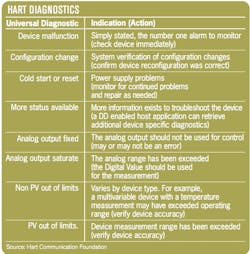Today, even though 25 million-plus Hart-enabled devices are installed in locations around the world, myths and misconceptions about this technology abound. The misconception that “Hart is only good for device setup, calibration and maintenance” was cemented in users’ minds because that’s how they learned to use Hart—with a handheld communicator. Clinging to this misconception robs users of access to valuable information that can help keep their processes running at optimal levels. Users need to understand that the Hart technology already in their installed equipment is more powerful than they have ever imagined. The first thing to know is that Hart Communication uses a single pair of wires to transmit two simultaneous communication channels—one unidirectional channel for the Primary Control Variable and one bidirectional, all-digital channel for the multi-variable, diagnostic and configuration information. The unidirectional 4-20 milliAmp (mA) analog channel offers the fastest possible data transfer rate (milliseconds) of the Primary Control Variable, while being fully backward-compatible to all existing analog only input/output (I/O) systems. The simultaneous two-way digital channel has no effect on the 4-20 mA process variable (PV) transmission, but provides access to real-time device status, diagnostics and multivariable information that resides in the device. Every Hart-enabled device manufactured, from the smallest temperature transmitter to the most sophisticated Coriolis flowmeter or gas analyzer, has a minimum set of universal diagnostics. Every device must report a device malfunction, configuration changes, cold start or reset, more status available, PV analog output fixed, PV analog output saturate, non-primary variable out of limits and primary variable out of limits. Each diagnostic alert can help keep the process running and measurements accurate. From warnings of improper device reconfigurations, to inaccurate measurement values or device malfunctions, Hart-enabled products, when listened to, will provide valuable process information. If the system listened for only one error, Device Malfunction, untold operational expenses could be avoided just by knowing about a potential problem before it becomes a real one. Through the continuous monitoring of the Hart Communication digital channel, potential system failures or quality assurance anomalies can be easily detected at the device level. Detectable failures include in-range sensor failures, 4-20 mA distortion (analog output does not equal PV), incorrect set-up and a device/input mismatch. It is also possible to detect, for audit trail purposes, anomalies such as when device set-up changes or when self-tests or resets occur. Here’s the trick Even though many users are beginning to understand the value of the information that resides in their Hart devices, accessing that information is the trick. Eighty-five percent of the devices currently in the field are connected to legacy, analog-only I/O systems that cannot understand the encoded Hart digital information. Because users cannot reasonably justify replacing their current control systems with Hart-enabled versions, they must seek ways to retrofit the existing systems in order to gain access to the information. One way to put this valuable data within easy reach is to adopt the new WirelessHart standard. WirelessHart provides secure, reliable and robust wireless connectivity for Hart-enabled devices already in the field. With little or no change to the control loop, WirelessHart adapters can be connected anywhere on the loop in as many places as needed to provide continuous monitoring of the intelligent device without affecting the control system. Continuous communication between the field device and control system enables the automatic detection of problems with the device so that corrective action can be taken and costly process disruptions avoided. Understanding and utilizing the full capabilities of Hart Communication can be a major cost savings opportunity for industry users. Ed T. Ladd, Jr., [email protected], is Director of Technology Programs at the HART Communication Foundation.
About the Author
Ed T. Ladd
Automation World Contributer
Sign up for our eNewsletters
Get the latest news and updates

Leaders relevant to this article:
